
Inulin (a prebiotic fiber) can now treat food allergies better, suggests a new study. The findings of the study are published in the journal Nature Materials (1✔ ✔Trusted Source
Inulin-gel-based oral immunotheraphy remodels the small intestinal microbiome and suppresses food allergy
).
A study from the University of Michigan has identified a potential new treatment for food allergies in inulin, a naturally occurring plant fiber commonly used as a supplement, a prebiotic in soda, a replacement for sweeteners and for other products and purposes.
Advertisement
Inulin Offers New Hope for Food Allergy Sufferers
In what appears to be a major advancement that offers the promise of relief to food allergy sufferers around the world, the study describes inulin gel-based oral immunotherapy’s success in stopping allergic reactions in mice by, in part, targeting bacteria in the gut. The gel prevented severe allergic reactions during and even after being administered, including reactions to common triggers such as peanuts, egg white and milk.
The research, conducted by an international team of scientists in pharmaceutical sciences, biomedical and chemical engineering, internal medicine and other specialties, proposes that inulin gel addresses the root cause of food allergies, rather than just managing symptoms.
The research was led by James Moon from U-M’s College of Pharmacy. He has studied inulin’s potential to treat disease for years. He said inulin gel-based therapy holds great promise due to its safety profile and potential for large-scale production.
Advertisement
Inulin: A Healthy Prebiotic Fiber
“Inulin, a widely consumed dietary fiber recognized as safe by the FDA, forms the basis of the gel, making it a feasible and translatable option for clinical use,” said Moon, whose lab develops drug delivery technologies combined with pharmaceutics and engineering to identify ways for the body to fight disease. Moon is the J. G. Searle Professor of Pharmaceutical Sciences.
While further research and clinical trials are needed to test the findings, the study, which emphasized the role of the small intestine’s microbiota and metabolites in food allergy regulation, opens potentially life-changing new avenues for therapeutic interventions, he said. Other, newer treatment options have seen low uptake due to adverse reactions and spotty effectiveness.
Advertisement
Growing Burden of Food Allergy
As many as 1 in 3 adults and more than 1 in 4 children have food allergies, a life-altering condition that is getting harder to manage as allergens can be hidden in a variety of foods and drinks, according to the Centers for Disease Control and Prevention (2✔ ✔Trusted Source
More Than a Quarter of U.S. Adults and Children Have at Least One Allergy
).
Food allergies have become a significant concern globally, especially in developed nations, as accidental exposure to allergens can trigger severe reactions, including death.
The research found that inulin gel, specifically formulated with an allergen, normalized the imbalanced intestinal microbiota and metabolites in allergic mice. This normalization led to the establishment of allergen-specific oral tolerance, effectively suppressing allergic reactions to various food allergens.
“The therapy showed long-lasting protection even after the cessation of treatment, indicating its potential for sustained relief from food allergies,” said Fang Xie, a graduate student who also led the studies.
Inulins are a group of polysaccharides and natural storage carbohydrates in more than 36,000 plant species, including wheat, onion, asparagus and chicory, which is most often used to manufacture supplements.
The fiber is also the subject of research and clinical trials investigating its role in treating or leading to better understanding of cancerous tumors, gastrointestinal illnesses, diabetes and other diseases.
References:
- Inulin-gel-based oral immunotheraphy remodels the small intestinal microbiome and suppresses food allergy – (https://www.nature.com/articles/s41563-024-01909-w)
- More Than a Quarter of U.S. Adults and Children Have at Least One Allergy – (https://www.cdc.gov/nchs/pressroom/nchs_press_releases/2022/20220126.htm)
Source-Eurekalert



